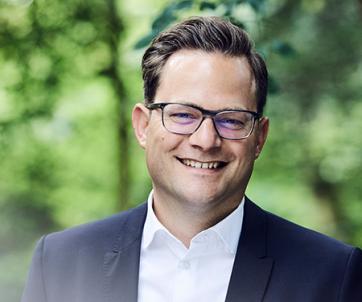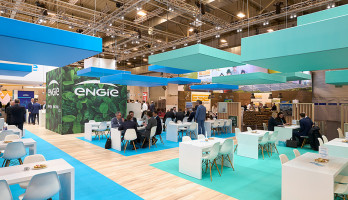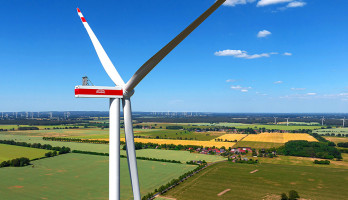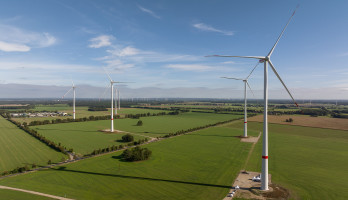
Sustainability in the real estate industry: Which investment criteria are important now
With its taxonomy criteria, the EU makes the sustainability of financial products and investments measurable in the future and defines specific requirements – also and especially for the real estate sector. What impact does the EU Taxonomy Regulation have on the real estate industry? What are the opportunities and challenges? And where can a link be established with the ESG sustainability aspects? In the interview: Jan von Mallinckrodt, Head of Sustainability at Union Investment Real Estate.
What does EU taxonomy mean for the real estate industry?
The EU taxonomy regulates what is considered to be sustainable precisely in the context of the European Action Plan on Sustainable Finance. The taxonomy covers six destinations:
- Climate protection
- Adaptation to climate change
- Sustainable use and protection of water and marine resources
- Transition to a circular economy, waste prevention and recycling
- Prevention and control of pollution
- Protecting healthy ecosystems
The real estate industry is categorized into four areas: New construction, renovation, purchase and inventory as well as individual measures. Sustainable buildings in the portfolio are those which have an EPC rating of A or whose primary energy demand is reduced by at least 30 percent through a refurbishment. The latter would then fall into the category of renovation.
For new buildings, i.e. properties completed from 2021 onwards, the following applies: they must consume 10 percent less primary energy than a lowest-energy building according to local definition. The property must also be resilient to climate change based on scenarios for climate projections over the life cycle of the property, but for at least 30 years from the time of the investment.
For new buildings and renovations, at least 70 percent (by weight) of construction and demolition waste must be recycled and no asbestos or other hazardous materials must be used. In addition, water-saving fittings and water use and water protection management plans are mandatory.
What role does EU taxonomy play in your real estate portfolios?
The aspect of sustainability in the real estate industry, especially in connection with the EU taxonomy, is an important issue for us. We are called upon to live up to our responsibilities and make our contribution. At Union Investment, sustainability has been a central building block and has been firmly anchored strategically for around 15 years. Since 2009, a team of seven experts based on established valuation systems has been responsible for the implementation and further development of the sustainability strategy in the real estate sector. In 2018, Union Investment has also set itself the goal of making its real estate portfolio climate-neutral by 2050 with the Manage-to-Green strategy.
In practical terms, the ESG criteria of an property or a project development are checked in every purchase process with the help of our in-house Sustainable Investment Check, SI-Check for short. In addition, our existing buildings are analyzed once a year in order to show potential for a continuous improvement in sustainability performance. The SI check covers a total of seven categories, including building structure-relevant data, measures in operation and user comfort. The properties can achieve a rating between 0 and 5. This way we know at an early stage what the building's strengths and weaknesses are and what needs to be done in the short or medium term.
Why has the topic of ESG (Environment, Social and Governance) become so important for you?
Since the Paris Agreement on Climate Change and the UN 2030 Agenda for Sustainable Development in 2015 at the latest, it has been established that: It is no longer a question of whether, but only how sustainability or climate protection is implemented in the real estate industry. In order to achieve the ambitious goals of the Paris Agreement on Climate Change, local laws, regulations and building regulations of the member states are likely to be further tightened in the coming years.
The latest ruling by the Federal Constitutional Court demanding stricter climate protection from Germany is just another clear signal in the direction of sustainability. And even the United Nations Climate Change Council, in its latest report, confirmed that people are changing the climate and that we need to act quickly to halt climate change. The provisions of the respective laws could also be linked to sanctions if portfolio holders do not further develop their portfolio along the identified climate path. In some countries, appropriate regulations have already been adopted.
An increasing number of large companies are also putting pressure on property owners to make their land sustainable – in part forced: For example, the Hague District Court ordered Shell to reduce its carbon dioxide emissions by 45% by 2030 compared to 2019. There is simply no way around the decarbonization of the real estate inventory.
And what must be clear: The financial sector plays a key role here, as it can steer investments into sustainable investments. However, the recent accusation of green-washing in the financial sector has shown that we should do this conscientiously.
What is the connection between taxonomy and the ESG topic?
Taxonomy mainly covers the "E" in the ESG criteria, environmental protection. After all, measures such as energy optimization of buildings covered by the "E" are also those that contribute particularly strongly to limiting global warming. For us as investors and stockholders, however, the minimum social requirements are also of decisive importance. The latter are derived from the core labor standards of the ILO, the OECD Guidelines for Multinational Enterprises, as well as the UN Principles for Business and Human Rights and the International Charter of Human Rights.
In order to make sustainable transformation possible, considerable investments are necessary, which should be carried out in a socially responsible manner. In addition, it is crucial in our business area that users – that is, our tenants – recognize the added value of sustainability for buildings, value them and join us in taking the path.
Now a heretical question: Is this not primarily a political issue and will tenants not be able or willing to pay for it anyway?
As I said: Sustainability is no longer a voluntary exercise, but a duty. Decarbonization is the only way to halt climate change. At the same time, however, our buildings can only be contemplated together with their users – our tenants. In addition, the properties belong to our customers, the investors. That is why communication and awareness-raising play a crucial role. Finally, the tenant can benefit from more sustainability in the building, especially through decreasing ancillary costs.
"Properties that you don't do anything about today are worth nothing tomorrow"
Jan von Mallinckrodt,
Head of Sustainability at Union Investment Real Estate
Keyword "stranded assets": Can you please explain this concept briefly?
A "stranded asset" is a property whose value falls unexpectedly. For example, it is likely that investment managers who ignore political climate targets will face economic disadvantages. Disadvantages may arise either in the form of possible sanctions such as CO2 levies or through a continuous depreciation of the property concerned within the framework of the regular and statutory valuation rounds of the independent property experts. A realistic scenario is that individual properties with particularly high CO2 emissions are devalued to such an extent that they can no longer be traded on the commercial real estate market and are thus "stranded".
What do "stranded assets" mean in the context of your investment policy and how do you deal with them against the background of the climate protection goals?
There are currently no stranded assets in our portfolio, because we have a clear strategy for how we transform our real estate portfolio into a sustainable inventory. We call this the "manage to green" strategy. For example, we check the energy consumption and emissions of our buildings and compare them. If a building has an above-average level of consumption, we will use our Property Manager to investigate this. In some buildings we have already installed energy monitoring systems. This allows the complex technical systems to be controlled so precisely that considerable savings in energy consumption can be achieved. Years ago, we also converted all our properties in Germany to green electricity in the general areas and have now extended this to some European countries. Whenever appropriate, conventional lighting is also replaced by LEDs.
Often an improvement can be achieved with simple measures. You just have to recognize the problem. To manage the complex data, we use "ImmoSustain", a special software that has been developed and adapted specifically for Union Investment. Of course, technologies such as artificial intelligence are now also being used here, which makes working with the data much easier for all parties involved and less prone to errors. For example, we automatically read the consumption data of a property from the utility bills.
Keyword: Investor-user dilemma: How do you solve this familiar dilemma against the background of the CO2 and climate protection goals? How do the topics above affect the rents? Aren't they going up automatically?
The investor-user dilemma slows down the sustainable transformation of the real estate inventory, that much is clear. Rents do not increase automatically. The investor and thus the owner of the property pays the costs for the decarbonization or the energy optimization, but as a rule the expenses cannot be allocated to the user, who in turn benefits in the form of lower ancillary costs.
The investor-user dilemma has been an unresolved issue for years. Here, we need to find a balanced solution, distribute costs fairly and minimize hurdles. Politicians are also called upon to make sustainable transformation possible.
As an energy service provider, what would you advise us to do to ease your pain, even on this very difficult path?
For us, the consumption levels in the properties are particularly relevant. They enable us to derive optimizations and implement sensible measures on and in the buildings. However, it is not easy to get the relevant data. Often we are only informed about the power consumption of the so-called common areas. We are dependent on the consent of our users for the tenant consumption. We've made a lot of effort to get this data, but it remains difficult. We are not interested in the data of the individual tenant, but only want to calculate the total consumption of the property. This is the only way we can assess the properties correctly.
One way to solve this dilemma, we think, is for utilities and energy service providers to provide us with the data. However, these usually refer to data protection and do not make the usage for multi-tenant objects available to us. A straightforward solution would be very desirable here, because only together can we come to grips the enormous efforts to meet the requirements of the real estate industry and the mitigation of climate change.
Our Expert











